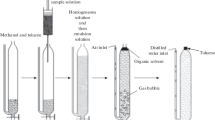Abstract
Accelerated solvent extraction (ASE) shows higher recoveries for PAHs in comparison with traditional Soxhlet extraction, but in a fraction of time and with less solvent consumption. Better recoveries are especially achieved with PAHs of high reactivity, the latter being expressed by the structure-to-count ratio (SCR). To estimate polar pollutants including phenols/benzenediols, the sample was subjected to a combined in-situ derivatization/extraction approach using 2% v/v acetic anhydride in toluene. The main reason for the better recovery obtained in this way, in comparison with the classical ASE approach, is to overcome strong matrix-analyte interactions. Analogously, fatty acids were analyzed as methyl esters obtained by in-situ derivatization/extraction using boron trifluoride.
Similar content being viewed by others
Author information
Authors and Affiliations
Additional information
Received: 28 December 1998 / Revised: 16 February 1999 / Accepted: 21 February 1999
Rights and permissions
About this article
Cite this article
Pörschmann, J., Plugge, J. Extraction of polar and hydrophobic pollutants using accelerated solvent extraction (ASE). Fresenius J Anal Chem 364, 643–644 (1999). https://doi.org/10.1007/s002160051403
Issue Date:
DOI: https://doi.org/10.1007/s002160051403




